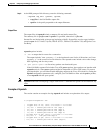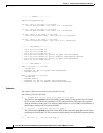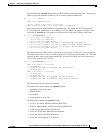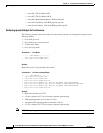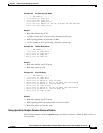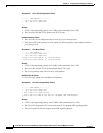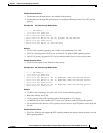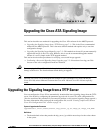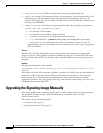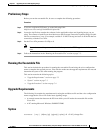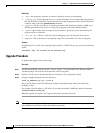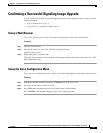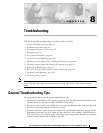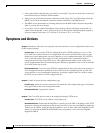
CHAPTER
7-1
Cisco ATA 186 and Cisco ATA 188 Analog Telephone Adaptor Administrator’s Guide for MGCP (version 3.0)
OL-4803-01
7
Upgrading the Cisco ATA Signaling Image
This section describes two methods for upgrading the Cisco ATA software for the MGCP protocol:
• Upgrading the Signaling Image from a TFTP Server, page 7-1—This is the Cisco-recommended
method for the MGCP protocol. This is the most efficient method and requires only a one-time
configuration change.
• Upgrading the Signaling Image Manually, page 7-2—This method can be used if you must manually
upgrade the image of one Cisco ATA. However, this is not the recommended upgrade method
because it is not as simple as the TFTP upgrade method.
This section also describes procedures for verifying a successful image upgrade:
• Confirming a Successful Signaling Image Upgrade, page 7-5—Procedures for using your Web
browser or the voice configuration menu are included.
Caution Do not unplug the Cisco ATA while the function button is blinking. Doing so can cause permanent
damage to the device. The function button blinks during an upgrade.
Note The term Cisco ATA is used throughout this manual to refer to both the Cisco ATA 186 and the
Cisco ATA 188, unless differences between the Cisco ATA 186 and Cisco ATA 188 are explicitly
stated.
Upgrading the Signaling Image from a TFTP Server
You can configure the Cisco ATA to automatically download the latest signaling image from the TFTP
server. You do this by configuring the parameter upgradecode in your Cisco ATA configuration file.
(You also would use this procedure if you wanted to perform a cross-protocol signaling image upgrade.)
For more information about setting up the configuration file, see the “Creating Unique and Common
Cisco ATA Configuration Files” section on page 3-9.
Syntax of upgradecode Parameter
upgradecode:3,0x301,0x0400,0x0200,tftp_server_ip,69,image_id,image_file_name
Definitions
• The hexadecimal values that precede the tftp_server_ip variable must always be the values shown
in the syntax.



